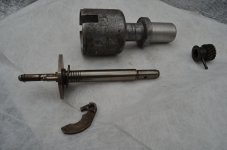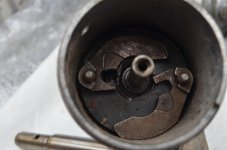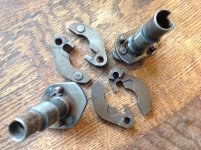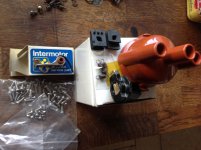This is the problem, they don't they are pinned in situ!
I'm fortunate ???

to have several distributors of both types and some of them which are partly dismantled. A few images with description might help to explain what's going on with the weights.
The first image shows the lower (driven) part of the mechanism on the 594/652 distributor with the drive cog removed and one of the weights separated from the post which it sits on.
The second image shows the two weights in-situ and you can see that the slot in one of the weights aligns with a hole in the driven plate below. This setup is very important in limiting the full advance of the distribitor as will be seen in the next image.
The third image shows the cam and the studs or pegs beneath it which sit in the slots in the weights previously referred to. As the distributor spins, the cam is not directly driven but receives its motion via these pegs being in contact with the slots in the weights. As the longer peg is restricted from full movement by also being inserted in the hole in the drive-plate, once the full 28 degrees advance is achieved it is not possible to pass this position and to enter into self-destruction of the mechanism. You can see the felt plug which should be in the hollow in the top of the spindle where a few drops of oil should be sparingly added when servicing. This is the oil eventually lubricates the pivots within the mechanism.
In the final image you see the cam-plate fitted and the two springs which when fully assembled are also fitted to the tops of the posts on which the weights pivot. When new, these springs must have been very carefully calibrated as they are intended to regulate the rate at which the weights cause the cam-plate to rotate. Without them, full advance would be achieved almost immediately the engine speeded up.
So you can see that not only must the weights be able to pivot freely, they must also be fitted correctly and be appropriate to the distributor in which they are installed.
The springs need to be the correct ones, they need to be undamaged and must be securely fitted over the posts.
The whole setup is probably rarely seen, being largely hidden under the contact breakers. I suspect that there are many faulty distributors running on cars where the resulting lack of or uncontrolled advance will create problems. All of this is in addition to the many other aspects of the drive mechanism of the distributor which can be worn or damaged.
The state of the item I photographed here was almost certainly the reason why the engine it came from finally gave up on the previous owner; one of the pivot-posts had actually broken off.

When that same engine was fitted with a distributor in good condition it ran perfectly.
The 499cc distributor has a very similar internal arrangement and I think that some parts will physically be interchangeable. But such a mongrel piece of kit might show some odd symptoms which would not be easy to diagnose.
For me, the major advantage that I originally saw in the 123 distributor was that you get a superbly engineeered, brand-new mechanism; the electronic advantages can be seen as a bonus. But if you get to grips with these internal details and get everything clean and running like clockwork, it is very hard to differentiate with the way the engine will start and run when compared with the 123.











